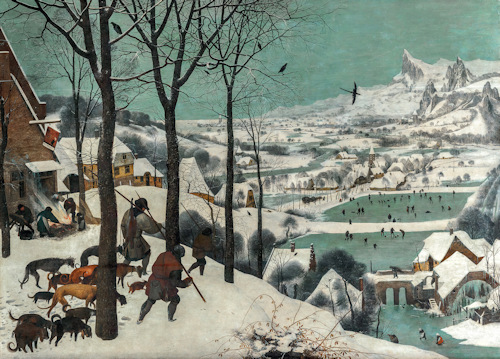
A thirst for knowledge quickly turns into a parched throat and empty stomach as mountains of art take their toll on your energy levels. In the Kunsthistorisches Museum, help is at hand at the museum’s café-restaurant on the first floor.
- Stunning location for the café-restaurant
- Like sitting inside your own masterpiece
- Typical Viennese coffee shop flair
- Bruegel chocolate, anyone?
- Book your museum tickets* online
- See also:
The café

(Figures in a Tavern or Coffee House, Attributed to Joseph Highmore, 1692–1780. Image courtesy of the Yale Center for British Art)
The café follows the traditional Viennese coffee house approach. On my visit, the staff had that lovely cultivated, formal politeness where you can spend many a happy hour trying to decide what they’re really thinking.
Last time I checked, the menu included a wide range of coffees, teas, soft drinks, beers, wines, and some cold and hot snacks & meals featuring typical Viennese tastes with one or two vegetarian and other options, as well.
On an earlier visit, I enjoyed a rather fine and filling red lentil salad washed down with a lemon soda.
Given the artistic location, I should perhaps have ordered vermouth and laudanum drunk from the shoe of a passing Prussian duchess. (That wasn’t on the menu, strangely.)
If you’re on a budget, this might not be your first choice, although prices are fairly normal for Vienna’s upmarket city centre locations in current times.
And what a truly magnificent setting to sup your coffee.
You sit below the main dome on an upholstered chair or sofa. Eight arches with black and gold columns lift your eyes up past playful statues and angels to reliefs honouring the likes of Archduke Ferdinand II and, of course, the ubiquitous Emperor Franz Joseph.
It’s the “if there’s a space then fill it” approach to architecture you also see in many Baroque churches in town.
Sitting below such an assault on the senses can intrigue, inspire, and intimidate in equal measure.
There’s something perhaps a little sad about it all, too. So much creativity, emotion, time and expense invested by those who designed, built or commissioned the works. So much opulence and Habsburg self-belief (or arrogance if you prefer).
Did Emperor Franz Joseph sit here, too? Was he pleased? Did he imagine 900 years of self-glorification was soon to end in the trenches of WWI?
Don’t sit here alone: you might start thinking too much. (But then there’s always a dessert to revive the spirits.)
At the time of writing, they do a special breakfast service on weekends and public holidays as well as gourmet dinners here every Thursday evening. I include the latter in my list of suggested places for a romantic meal.
The dinners look absolutely fantastic. I’ve only ever seen them in passing, feeling like an orphan outside the grocery store in a Dickens novel…staring at the feast with wonder and amazement.
Tip: You can see the upper areas of the dome better if you go up to the second floor (the same floor as the coin collection) and look out from one of the balconies.
The museum shop

(You can’t buy the original, but you can buy a copy in one form or another: Hunters in the Snow, Pieter Bruegel the Elder (c. 1525/30 – 1569), 1565, oak panel, 117 × 162 cm; Kunsthistorisches Museum Vienna, Picture Gallery; © KHM-Museumsverband)
The main shop is on your right as you enter the museum and has everything you’d expect.
The focus, inevitably, is on books, exhibition catalogues, DVDs, postcards, souvenirs, and posters, but you’ll also find, for example, jewellery and miniatures. I liked the salt and pepper pots in the style of the Saliera: not cheap, but an awful lot cheaper than the original.
Outside of the Kunstkammer collection and the painting galleries, you may not find English everywhere. If you plan to explore the other collections without an audio guide, then you might want to get a book here.
Each of the individual museum collections has its own guidebook covering the masterpieces, for example. If you want to quickly browse everything, then a general guidebook obviously makes more financial sense.
Most of the items in the shop are helpfully split by collection. So if you’re looking for a postcard of that Titian or Rubens you just admired, try the painting section.
And you know you’re in the Kunsthistorisches Museum when you can buy chocolate with a Bruegel or Rubens-themed wrapping.
(Incidentally, the museum also has a smaller boutique shop up the stairs, next to the café/restaurant. And I’ve seen a pop-up Bruegel-themed store outside Gallery 10.)